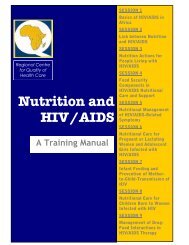2.1: Anthropometric Indicators Measurement Guide - Linkages Project
2.1: Anthropometric Indicators Measurement Guide - Linkages Project
2.1: Anthropometric Indicators Measurement Guide - Linkages Project
Create successful ePaper yourself
Turn your PDF publications into a flip-book with our unique Google optimized e-Paper software.
REFERENCES PART 9.<br />
Adolescent<br />
<strong>Anthropometric</strong><br />
<strong>Indicators</strong><br />
5.<br />
APPENDIX<br />
Adolescents are defined by WHO as those<br />
in the age range of 10 to 19 years. The<br />
nutritional status of this age group is<br />
difficult to assess because there is not a<br />
reference standard for adolescents and<br />
there is a growth spurt which occurs with<br />
puberty which occurs at different ages.<br />
This limits the ability to use a reference<br />
standard even if it is developed locally.<br />
The ACC/SCN has produced a paper on<br />
assessing nutrition status for emergencyaffected<br />
populations (Woodruff, and<br />
Duffield. Adolescents: Assessment of<br />
Nutritional Status in Emergency-Affected<br />
populations. SCN Geneva, July, 2000).<br />
acc.unsystem.org/scn<br />
The ACC/SCN recommends that due to<br />
a lack of validated anthropometric<br />
procedures for adolescents, anthropometry<br />
is not used without examining<br />
other population sub-groups and other<br />
determinants of nutrition and food<br />
security.<br />
As with children, adolescent<br />
anthropometric assessment is used to<br />
reflect undernutrition. Anthropometry is<br />
also used to reflect over nutrition but this<br />
is not the focus of this guide. Undernutrition<br />
in adolescents is characterized<br />
by patterns of acute and chronic<br />
deficiency of energy, protein and<br />
micronutrients including vitamins and<br />
minerals. Often a person is affected by<br />
both acute and chronic deficiency in all or<br />
some of the key nutrients. The<br />
manifestation of the deficiency and the<br />
measurement is, complicated to determine<br />
and the functional significance<br />
unclear. Undernutrition is characterized<br />
by a lack of food and while specific<br />
nutrient deficiencies occur, such as<br />
pellagra due to a lack of niacin, the<br />
primary cause is more general. We are<br />
learning more about specific nutrient<br />
requirements for diseases such as<br />
HIV/AIDS but the ability of anthropometrics<br />
to identify these conditions is<br />
limited.<br />
As with adults, adolescent anthropometric<br />
assessment is used for several purposes<br />
including:<br />
• screening or targeting individuals for<br />
some sort of intervention or action such as<br />
supplementary feeding during famine<br />
relief,<br />
• surveillance or monitoring of changes<br />
in prevalence and coverage in groups or<br />
populations to trigger a response including<br />
graduating from an intervention , and<br />
• evaluating the impact of activities or<br />
interventions.<br />
Anthropometry is used to describe the<br />
nutritional situation in a population and<br />
this can be useful for problem analysis<br />
and for evaluation. Because the<br />
determinants of nutrition are so many, it is<br />
important to examine other factors than<br />
just anthropometry such as the food<br />
security situation, levels of illness, care<br />
giving practices and so on.<br />
9.<br />
79

















